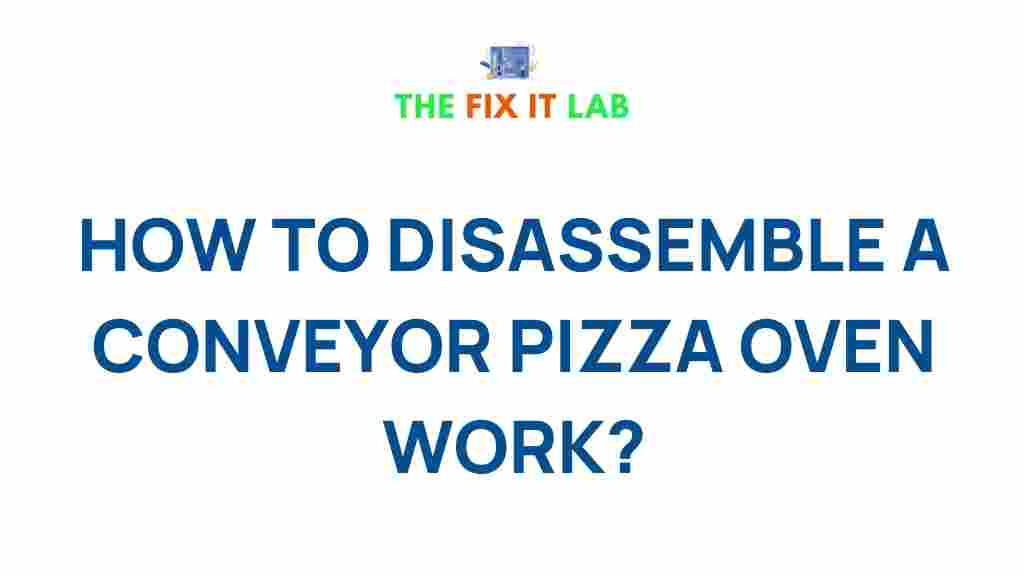Understanding the Conveyor Pizza Oven: A Step-by-Step Disassembly Guide
A conveyor pizza oven is an indispensable tool in the world of pizzerias and restaurants, ensuring consistent quality and high-volume output. However, like all equipment, these ovens require regular maintenance and occasional disassembly for repairs or cleaning. In this guide, we’ll explore the intricate process of disassembling a conveyor pizza oven, empowering you to maintain your equipment effectively.
Whether you’re dealing with a malfunction or performing routine upkeep, understanding the components and proper techniques for disassembly can save time, reduce costs, and extend the lifespan of your oven. Read on for a detailed guide, troubleshooting tips, and essential resources to enhance your skills.
Preparing for Conveyor Pizza Oven Disassembly
Tools and Safety Precautions
Before starting the disassembly process, gather the necessary tools and ensure safety measures are in place. Here’s what you’ll need:
- Screwdrivers (Phillips and flathead)
- Adjustable wrench
- Socket set
- Protective gloves
- Cleaning supplies (degreaser, microfiber cloths)
Safety is paramount. Turn off the power supply and unplug the oven to avoid electrical hazards. If your oven uses gas, shut off the gas supply as well. Ensure the oven has cooled completely before beginning.
Documentation and Manufacturer Guidelines
Refer to the user manual or manufacturer guidelines specific to your conveyor pizza oven. These documents often contain diagrams and detailed instructions tailored to your oven model. If you’ve misplaced your manual, check the manufacturer’s website or contact their support team.
Step-by-Step Guide to Disassembling a Conveyor Pizza Oven
Step 1: Remove the Conveyor Belt
The conveyor belt is a critical component and must be handled carefully. Follow these steps:
- Locate the tensioning mechanism and release the tension on the belt.
- Slide the belt off the rollers gently, avoiding excessive bending to prevent damage.
- Set the belt aside in a safe location for cleaning or inspection.
Step 2: Disassemble the Oven Chamber
Next, focus on the oven chamber, where most of the cooking occurs:
- Detach the side panels by unscrewing the screws securing them in place.
- Carefully remove internal components such as crumb trays, heating elements, or fans.
- Label each part to ensure proper reassembly later.
Step 3: Access the Motor and Drive System
The motor and drive system are vital for operating the conveyor belt. To access them:
- Locate the access panel near the base of the oven.
- Remove screws or bolts securing the panel, exposing the motor and drive system.
- Inspect for wear or damage and clean components as needed.
Step 4: Clean and Inspect Components
With the oven disassembled, take the opportunity to clean and inspect each part:
- Use a degreaser to remove grease and food debris from panels and trays.
- Inspect belts, gears, and heating elements for signs of wear or damage.
- Replace any faulty components to ensure optimal performance.
Step 5: Reassemble the Oven
Reassembly is as important as disassembly. Follow these steps to put your conveyor pizza oven back together:
- Reattach the motor and drive system, ensuring all connections are secure.
- Replace the oven chamber components, following the labels you created earlier.
- Reinstall the conveyor belt and adjust the tension properly.
- Test the oven to ensure it operates correctly before full use.
Troubleshooting Common Issues
Conveyor Belt Not Moving
If the conveyor belt isn’t functioning, check for these issues:
- Ensure the belt tension is correctly adjusted.
- Inspect the motor and drive system for loose connections or wear.
- Replace the belt if it shows significant wear or damage.
Uneven Cooking
Uneven cooking often stems from misaligned heating elements or a dirty oven chamber:
- Ensure heating elements are positioned correctly and free of debris.
- Clean the chamber thoroughly to prevent airflow blockages.
- Test the oven’s temperature settings to confirm proper calibration.
Conclusion
Disassembling a conveyor pizza oven might seem daunting, but with the right tools and knowledge, the process becomes manageable. By following this guide, you can perform maintenance tasks confidently, extending the life and efficiency of your oven. Regular cleaning and inspection not only improve performance but also prevent costly repairs down the line.
For more detailed tips and maintenance advice, visit our oven care guide. Stay informed and keep your kitchen equipment running smoothly!
This article is in the category Guides & Tutorials and created by TheFixitLab Team
